|
Headgear from Ancient Battles
by Bob Brooke
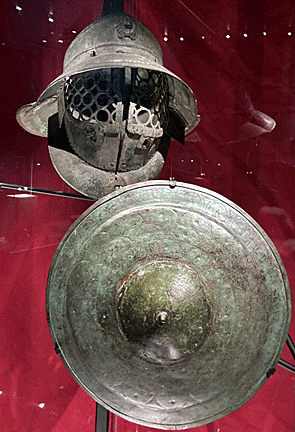 Military
use of helmets declined after 1670, and rifled firearms ended their
use by foot soldiers after 1700 but the Napoleonic era saw ornate
cavalry helmets reintroduced for cuirassiers and dragoons in some
armies which continued to be used by French forces during World War
I as late as 1915. A combat helmet or battle helmet is a type of
helmet, a piece of personal armor designed specifically to protect
the head during combat. Military
use of helmets declined after 1670, and rifled firearms ended their
use by foot soldiers after 1700 but the Napoleonic era saw ornate
cavalry helmets reintroduced for cuirassiers and dragoons in some
armies which continued to be used by French forces during World War
I as late as 1915. A combat helmet or battle helmet is a type of
helmet, a piece of personal armor designed specifically to protect
the head during combat.
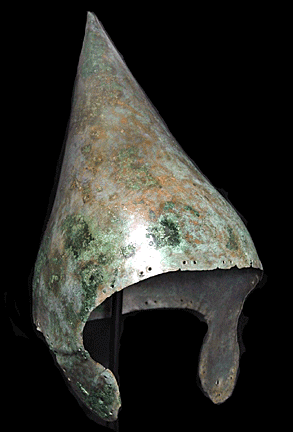 Helmets
are among the oldest forms of personal protective equipment and are
known to have been worn by the Akkadians/Sumerians in the 23rd
century BCE. Mycenaean Greeks since the 17th century BC, the
Assyrians around 900 BC, ancient Greeks and Romans, throughout the
Middle Ages, and up to the end of the 17th century by many
combatants. As weapons became more and more powerful, helmet
materials and construction became more advanced. Helmets
are among the oldest forms of personal protective equipment and are
known to have been worn by the Akkadians/Sumerians in the 23rd
century BCE. Mycenaean Greeks since the 17th century BC, the
Assyrians around 900 BC, ancient Greeks and Romans, throughout the
Middle Ages, and up to the end of the 17th century by many
combatants. As weapons became more and more powerful, helmet
materials and construction became more advanced.
Initially constructed from brass and leather, then bronze and iron
during the Bronze and Iron Ages, they soon came to be made entirely
from forged steel after about 950 CE. During that time, helmets were
purely military equipment, protecting the head from cutting blows
with swords, flying arrows, and low-velocity musketry.
Ancient Greek Helmets
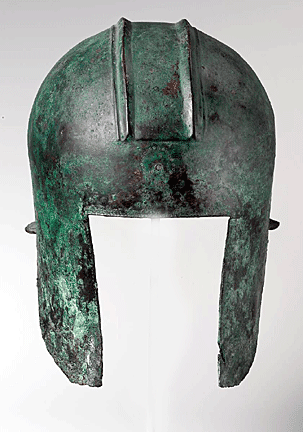 Ancient
Greek helmets were often a status symbol, with members of elite
groups wearing more ornate ones. Ancient
Greek helmets were often a status symbol, with members of elite
groups wearing more ornate ones.
The Illyrian helmet, one of two helmets to appear in the early 7th
century BCE, was the most common one. It had a square face guard and
pointed non-hinged cheek pieces, as well as the smooth dome
featuring raised parallel ridges to which a crest made from
horsehair, wood or leather would be pinned in place by a rivet at
the crown.
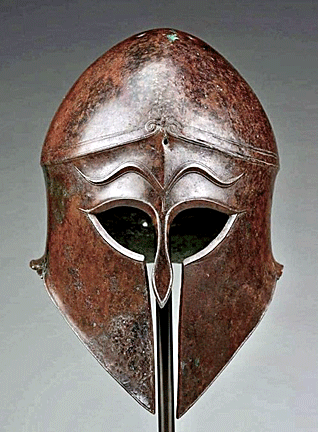 The
Corinthian helmet was the other 7th century helmet, with its
characteristic almond-shaped eyes and rounded nose guard. The domed
head, the slightly flaring neck guard, the elongated eye openings
created a beautiful form. The
Corinthian helmet was the other 7th century helmet, with its
characteristic almond-shaped eyes and rounded nose guard. The domed
head, the slightly flaring neck guard, the elongated eye openings
created a beautiful form.
The Pilos helmet, a later and simpler variation, featured a conical
dome with a recessed band along the lower edge, most likely
mirroring a felt or animal-skin cap worn by herdsmen. It was a
lighter helmet, with hinged cheek-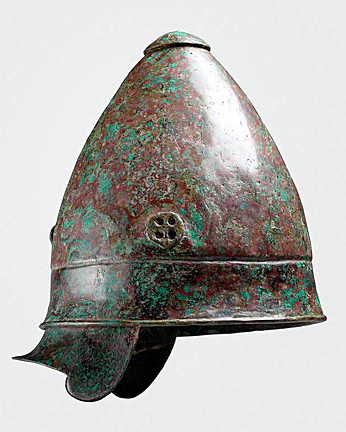 pieces,
and more versatile for the warrior, allowing for more flexibility in
battle. Some had ornate molded decorations. pieces,
and more versatile for the warrior, allowing for more flexibility in
battle. Some had ornate molded decorations.
Corinthian helmets originally covered the face for maximum
protection but also restricted the ability to see, hear or breathe.
Gradually, the eye holes grew, and the nose guard became smaller to
become more versatile.
Eventually armorers created helmets from a single sheet f bronze,
making them quicker to produce as well as more stable and sturdier
for the warrior. This style of helmet was used from 6th century BC
to 1st century BC.
Ancient Roman Helmets
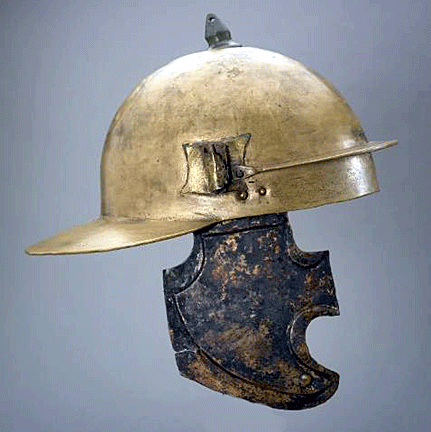 Helmets
were an important part of the Roman soldier’s equipment..Over the
centuries Roman armor changed significantly as a result of new
fashions, new technologies, and new challenges. The Roman produced
helmets in vast quantities. Surviving examples of Roman helmets
range from the plain and simple to the more elaborate. Helmets
were an important part of the Roman soldier’s equipment..Over the
centuries Roman armor changed significantly as a result of new
fashions, new technologies, and new challenges. The Roman produced
helmets in vast quantities. Surviving examples of Roman helmets
range from the plain and simple to the more elaborate.
Roman armorers made the Montefortino helmet from bronze, but they
also used iron. It had a conical shape and a raised central knob on
top. It also featured a protruding neck guard and cheek plates which
protected the side of the head. Often, the helmet had the name of
the soldier who wore it inscribed inside of it. Montefortino style
Roman helmets are very similar to the Coolus style of Roman helmets.
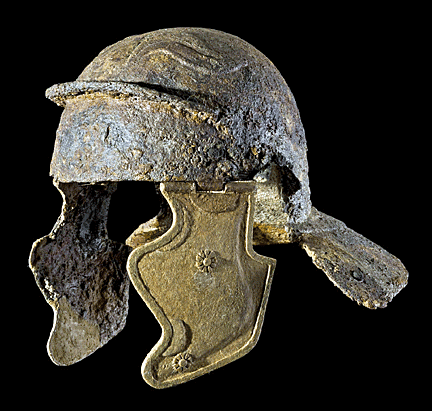 The
Coolus helmet originated with the Celts. The Romans adopted this
style because its simple design meant that they could be
mass-produced inexpensively. This was critical during this period as
many Roman citizens were called upon to serve in the army. The
Coolus style came into use during the 3rd Century BCE and remained
in service until the 1st Century CE. It saw its greatest use during
the period of Caesar’s Gallic Wars from 58 to 50 BCE, The
Coolus helmet originated with the Celts. The Romans adopted this
style because its simple design meant that they could be
mass-produced inexpensively. This was critical during this period as
many Roman citizens were called upon to serve in the army. The
Coolus style came into use during the 3rd Century BCE and remained
in service until the 1st Century CE. It saw its greatest use during
the period of Caesar’s Gallic Wars from 58 to 50 BCE,
The Coolus style of Roman helmet was usually made from brass or
bronze, though it is possible that some were also made of iron. They
were globular or hemispherical in shape rather than conical. These
Roman helmets also featured a neck guard and a turned, cast soldered
or riveted on crest knob. Like most helmets of Celtic origin, they
were pierced to allow for ties or cheek guards to be added to the
helmet.
Medieval Helmets
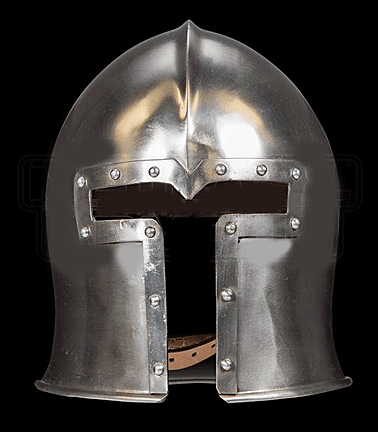 A
variety of different types of helmets appeared during the Middle
Ages. All offered another level of protection to warriors during
battles. A
variety of different types of helmets appeared during the Middle
Ages. All offered another level of protection to warriors during
battles.
Iron and steel were the primary materials used for medieval helmets,
just like the rest of the Armor. Back then, armorers. blacksmiths
who specialized in making quality armor. Sometimes, ordinary
blacksmiths made lesser in quality helmets. To identify a particular
regiment, armorers painted symbols or crests on them.
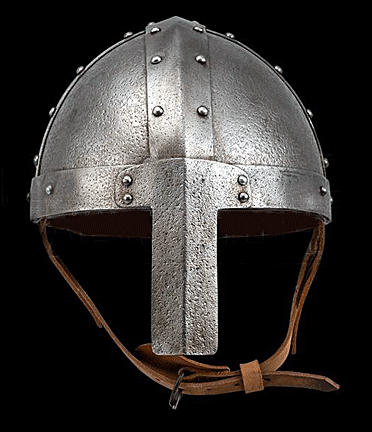 The
most common helmets during the early Middle Ages were open-faced,
like the spangenhelm. But they didn’t protect a soldier’s face very
well. They sometimes offered nasal protection. The head was and
still is one of the most important areas of the body to protect, as
wounds to the head and skull were often fatal. The
most common helmets during the early Middle Ages were open-faced,
like the spangenhelm. But they didn’t protect a soldier’s face very
well. They sometimes offered nasal protection. The head was and
still is one of the most important areas of the body to protect, as
wounds to the head and skull were often fatal.
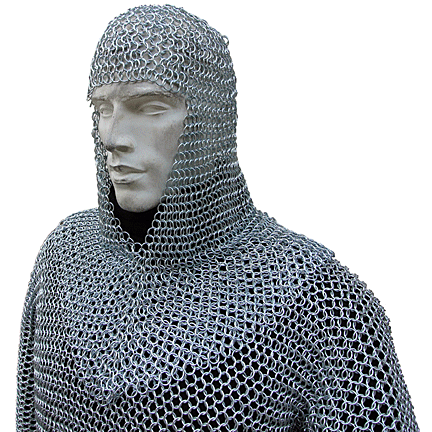 For
added protection, soldiers usually wore a mail coif--- a hood made
of chain mail—and padding underneath the helmet as extra protection
for the neck and head. The mail coif was usually sewed to a fabric
padding. The padding only covered the head, not For
added protection, soldiers usually wore a mail coif--- a hood made
of chain mail—and padding underneath the helmet as extra protection
for the neck and head. The mail coif was usually sewed to a fabric
padding. The padding only covered the head, not
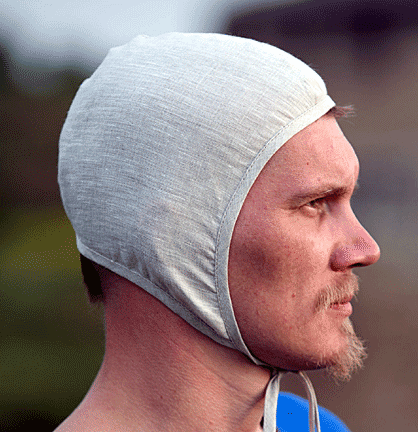 the
neck. It could be worn underneath a helmet or even without the
helmet at all. This was common gear for the soldiers of lower rank.
Most soldiers wore close-fitting coif, where the only open parts
were the nose and the eyes. A coif didn’t always have mail attached
to it. The word ‘coif’ can also refer to the padding alone. To some
types of helmets, like the bascinet, soldiers could attach an
aventail, a chain mail neck and shoulder protector. Soldiers could
also wear a padded coif underneath their helmets, without the chain
mail, for extra comfort and protection against bruises and chafing.
Coifs could also help a helmet fit better. the
neck. It could be worn underneath a helmet or even without the
helmet at all. This was common gear for the soldiers of lower rank.
Most soldiers wore close-fitting coif, where the only open parts
were the nose and the eyes. A coif didn’t always have mail attached
to it. The word ‘coif’ can also refer to the padding alone. To some
types of helmets, like the bascinet, soldiers could attach an
aventail, a chain mail neck and shoulder protector. Soldiers could
also wear a padded coif underneath their helmets, without the chain
mail, for extra comfort and protection against bruises and chafing.
Coifs could also help a helmet fit better.
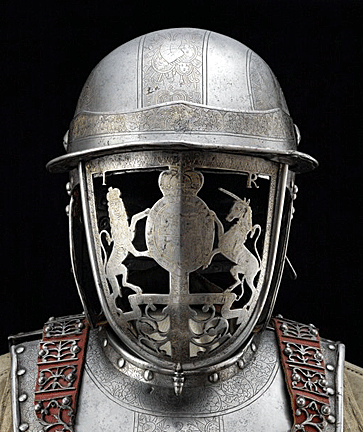 The
spangenhelms and nasal or Norman Helmets were in use in the early
Middle Ages, after which came the bascinet without a visor. By 1180,
helmets had visors with a holes to see and breathe through. The
spangenhelms and nasal or Norman Helmets were in use in the early
Middle Ages, after which came the bascinet without a visor. By 1180,
helmets had visors with a holes to see and breathe through.
Helmets used in Europe from the 9th century up to the 12th century
had a nose-guard down the middle of the soldier’s face. They were
some of the first helmets mostly made of iron and would eventually
be made from single sheets instead of segments. Soldiers wore them
over the top of a mail coif that provided additional protection for
the neck, throat and head. This type of helmet offered increased
protection due to the double layering of mail coif and iron.
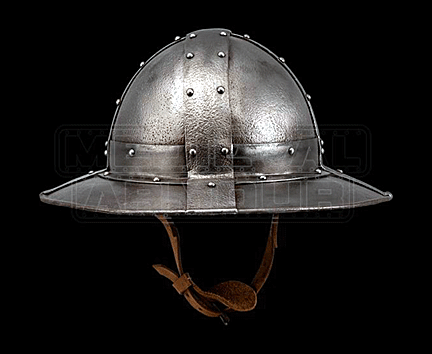 The
Kettle Helmet, also called Eisenhut and chapeau de fer, meaning “hat
of iron,” was the most popular helmet in the 11th century. Its name
came from its resemblance to a cooking pot, kettle, or cauldron.
These helmets always had a wide brim and were open-faced and were
also sometimes worn with a coif underneath. This was a common helmet
during the Middle Ages, mostly worn by infantry because it gave good
protection to blows that came from above, such as those from horse
soldiers, plus it kept the sun out of the wearers' face. Soldiers
could add an aventail if they wished. The
Kettle Helmet, also called Eisenhut and chapeau de fer, meaning “hat
of iron,” was the most popular helmet in the 11th century. Its name
came from its resemblance to a cooking pot, kettle, or cauldron.
These helmets always had a wide brim and were open-faced and were
also sometimes worn with a coif underneath. This was a common helmet
during the Middle Ages, mostly worn by infantry because it gave good
protection to blows that came from above, such as those from horse
soldiers, plus it kept the sun out of the wearers' face. Soldiers
could add an aventail if they wished.
From the early Middle Ages to the 10th century, the most commonly
used was the Spangenheim helmet, which got its name from its frame
made of strips, or “spangen” in German. These strips connected four
to six metal plates. Usually, the Spangenhelms had a broad nasal
strip to protect the nose and where conical in shape.
The earliest Spangenhelms had leather or metal cheek guards. But
those worn during the Middle Ages didn’t. Soldiers could also attach
an aventail to the helmet. This was a widely used type of helmet
because it was so easy to make and thus inexpensive to produce.
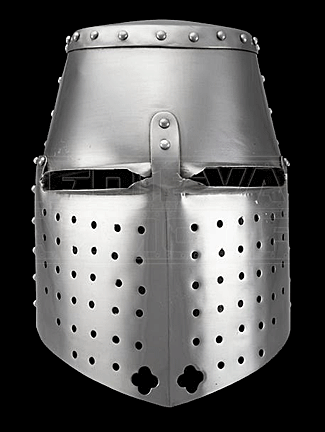 The
Great Helm evolved from the nasal helmet used from the 12th century
to around the 15th century. Knights in European armies during the
Crusades used this enclosed barreled style helmet which offered
superior protection, but at the cost of visibility and comfort. By
the 13th century, knights wore most Great Helms with a mail coif in
conjunction with an iron skullcap to provide three layers of
protection. Most could stop direct blows from broadswords and maces.
At first, these helmets had a square top, but they soon became a
target for hammers. Later designs had a conical top which lessened
the impact of hammers and swords. The
Great Helm evolved from the nasal helmet used from the 12th century
to around the 15th century. Knights in European armies during the
Crusades used this enclosed barreled style helmet which offered
superior protection, but at the cost of visibility and comfort. By
the 13th century, knights wore most Great Helms with a mail coif in
conjunction with an iron skullcap to provide three layers of
protection. Most could stop direct blows from broadswords and maces.
At first, these helmets had a square top, but they soon became a
target for hammers. Later designs had a conical top which lessened
the impact of hammers and swords.
The Great Helm was one of the first helmets that completely
protected the face and had small openings for eyes and perforations
for the mouth. By the 14th century, the entire helmet rested on the
shoulders of the knight. Underneath they wore extra protection made
out of cloth and fiber padding. This made the great helms very warm.
A leather chinstrap secured it to the head of the wearer.
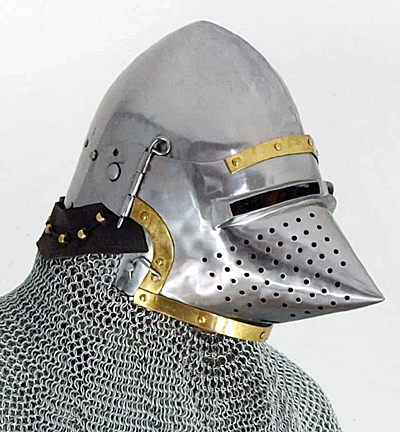 Often
armorers painted these helmets bright colors, matching the knight's
shield. They also adorned them with crests and decorated visors. Often
armorers painted these helmets bright colors, matching the knight's
shield. They also adorned them with crests and decorated visors.
From the 14th to the 15th century, the Bascinet, usually an
open-faced helmet, had a conical visor. This resembled a beak or a
snout, thus getting the nickname hounskull, which was medieval for
“dog-faced.” And because both knights and infantry used it, it
became very popular.
In the 14th century, The Bascinet replaced the Great Helm in
popularity. At first, infantrymen wore the Bascinet underneath their
Great Helmets. But soldiers often removed their Great Helmets so
they could move easier.
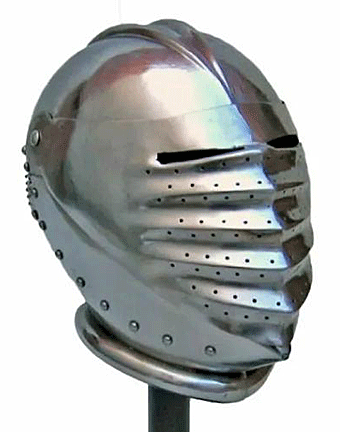 The
Italians first experimented with a helmet that more resembled the
form of the human head in the 16th century. This helmet, called the
Arnet, fitted closely around the head and was broader on the top and
narrower around the neck. Because the wearer couldn’t slide it over
his head, it was necessary to have a mechanism to open and close it
easily. The
Italians first experimented with a helmet that more resembled the
form of the human head in the 16th century. This helmet, called the
Arnet, fitted closely around the head and was broader on the top and
narrower around the neck. Because the wearer couldn’t slide it over
his head, it was necessary to have a mechanism to open and close it
easily.
Soldiers wore these helmets, which enclosed the face and head,
during the Late Medieval and Renaissance Periods. They were also
compact and light enough to move with the wearer. The Armet came
into widespread use during the 15h and 16th centuries when European
plate armor had been perfected by armorers.
Metal tempering and design greatly improved during this time.
Variations in designs limited the gaps in armor, lessening the
common weak points. Some Close Helms were even modular for heavy or
light field use, tournament combat, and even costume.
<
Back to More Antique Spotlights
Next Article >
|
